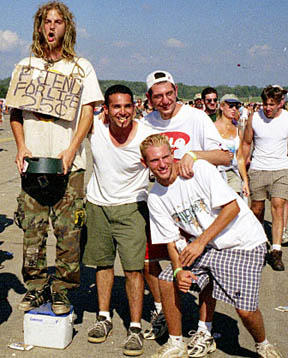
The mud people had the most fun. They released their inhibitions and just played. The mud was the result of water spigots placed over dirt rather than pavement but it is a Woodstock essential.
As the first two had been, Woodstock 99 was a feast for the senses. There were over 100 bands and 225,000 people in upstate New York. While it may have been tarnished by some youthful exuberance at the end, the people of Rome still want to host another one in five years.
Some thoughts and observations:
The music of today is every bit as good as it was in 1969. The musicians are as talented; the energy level is as high. Maybe some these bands will be as famous in 30 years as several of the then-unknown bands who played the first Woodstock. Performers like the Offspring, Dave Matthews or Alanis Morrisette put on incredible shows with top-notch musicians.
The sound quality was undoubtedly better. The massive audio systems provided remarkable fidelity from up to half a mile away. Yes, it was loud, but because it was so clear, it wasn't painful. And the sound was directional; in front of the stage it was great, off to the sides and at a distance it faded out so that one stage didn't interfere with another. I'm sure that was a major technological improvement over 30 years ago.
The place was huge. It was nearly a mile from one end to the other, nearly three to the ends of the camping areas. Parking went on for miles. If you walked away from the stages, you could actually find places to sit or lie down where you weren't being trampled. The 8,000-foot runway served as a state fair-type midway lined with food and organizational booths.

The mud people had the most fun. They released their inhibitions and just played. The mud was the result of water spigots placed over dirt rather than pavement but it is a Woodstock essential.
Nudity went essentially unnoticed. Nobody cared. Nobody should.
Portapotties are disgusting. Even when serviced regularly-- as these were. Somebody needs to invent a better booth.
Concession prices were high. Yes, bottled water and soda or lemon shake-ups were $4 from any official vendor but there were people selling things out of coolers for much, much less. There were people with ice and water in their backpacks selling it for $1 a bottle and beer for $1 a can. There was also unlimited tap water for free to fill up thermos jugs or water bottles. By comparison, pop and water were $3 each at the 1996 Olympics in Atlanta and the selection of food and drinks wasn't nearly as varied.
Festival seating-- or standing-- can be painful. While nobody died, may felt the crush. There needs to be some way to keep the pressure from the people in back wanting to go forward from impacting everyone in front.
There was too much alcohol and not enough pot-- too many drunks and not enough mellowing out. Probably it wasn't that way in 1969.
Rumors were rampant. In the media tent and in the trenches, there were rumors of deaths, bands canceling, and incidents of every imaginable kind-- all untrue. There needs to be a ''truth station'' or some way to sort them out.
Upstate New York is not at all like New York City. The people in Oneida County (the birthplace of Galesburg) were incredibly friendly, polite and helpful. Shuttle bus drivers would even stop along their routes and pick people up and take them places.
They don't know from humidity. While locals apologized for the heat, it was incredibly comfortable by our standards. The temperatures may have approached 90 degrees but the humidity was low and the air was clean.
We don't know from congestion. Traffic in the small towns of New York, like suburbs everywhere, is annoying as hell. I stopped in Batavia to drop in on former Galesburg City manager Bob Knabel (He was out to lunch) and even that town had frustrating traffic jams, one way streets, and confusing signage. Their City Hall was an embarrassment; it makes our old one look like a Taj Mahal.
New York and Ontario have the best roads.
Illinois and Michigan have the worst ones.
New York has the worst directional road signs. I stopped in Rochester to tour the George Eastman House and drove around in the neighborhood for half an hour without finding a sign or a resident who knew where it was. I circled downtown Buffalo several times trying to figure out the confusing directions to the bridge to Canada. Signs in Canada were great.
The rest of the country knows how to do road repairs. They do them at night. They keep two lanes open-- routing traffic onto the shoulder when necessary. Illinois has a lot to learn.
Asphalt should be banned from interstate highways. There were places where it was still fresh and black and already cracked and peeling up.
The fastest drivers are the Canadians. They have good roads and they take advantage of them. Their speed limit is the slowest (100kmh (62mph)) but the make the best time. Michigan has the fastest limit eastbound (70mph).
The rest of the country knows how to run a toll road. You pick up a ticket when you get on and pay when you get off. It sure beats stopping every few miles to wait in line and dig for change. Only Illinois does it that way.